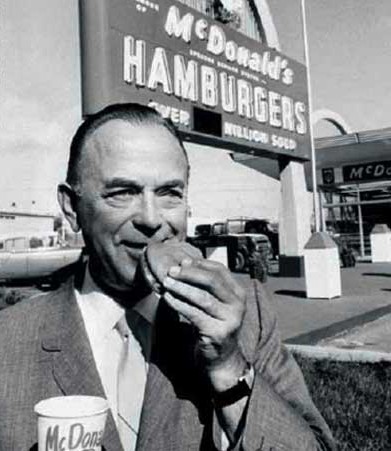Ray Kroc, the larger-than-life figure who turned the McDonald’s “hamburger stands” into a megapower after joining the company in the mid-’50s, just couldn’t help but make money. Here’s Kroc discussing his finances with Sports Illustrated in 1974, in an article tied to his purchase of the San Diego Padres:
“Money is an automatic thing with me,” he said, adjusting his chair. “It’s like turning on a light switch. I take it for granted. What do I need it for? I’ve never desired a harem—anyway, I’m too old for one now. I’ve never wanted to own a racehorse or even a polo pony. What are you gonna do with money? I eat one steak at a time and I buy my clothes off the rack—can’t stand custom-made clothes. All money represents to me is pride of accomplishment.”
McDonald’s isn’t so fortunate these days, though, as the chain, which is terrible for animals, people and the environment, has faced strong market resistance the past two years. A brief downturn, perhaps, though poor management, strong competition and shifting tastes may mean a longer decline. From “When the Chips Are Down,” a new Economist article about the tarnish on the Golden Arches:
The biggest problem has been in America—by far McDonald’s largest market, where it has 14,200 of its 35,000 mostly franchised restaurants. In November its American like-for-like sales were down 4.6% on a year earlier. It had weathered the 2008-09 recession and its aftermath by attracting cash-strapped consumers looking for a cheap bite. But more recently it has been squeezed by competition from Burger King, revitalised under the management of a private-equity firm, from other fast-food joints such as Subway and Starbucks, and from the growing popularity of slightly more upmarket ‘fast casual’ outlets.
In response, McDonald’s has expanded its menu with all manner of wraps, salads and so on. Its American menu now has almost 200 items. This strains kitchen staff and annoys franchisees, who often have to buy new equipment. It may also deter customers. ‘McDonald’s stands for value, consistency and convenience,’ says Darren Tristano at Technomic, a restaurant-industry consultant, and it needs to stay true to this. Most diners want a Big Mac or a Quarter Pounder at a good price, served quickly. And, as company executives now acknowledge, its strategy of reeling in diners with a ‘Dollar Menu’ then trying to tempt them with pricier dishes is not working.
McDonald’s says it has got the message and is experimenting in some parts of America with a simpler menu: one type of Quarter Pounder with cheese rather than four; one Snack Wrap rather than three; and so on. However, this seems to run contrary to the build-your-burger strategy it is trying elsewhere, which expands the number of choices. That in turn is McDonald’s response to the popularity of ‘better burger’ chains, such as Shake Shack, which has just filed for a stockmarket flotation.
Some analysts think that McDonald’s should stop trying to replicate all its rivals’ offerings and go back to basics, offering a limited range of dishes at low prices, served freshly and quickly.•
Tags: Darren Tristano, Ray Kroc

